Füge eine Handlung in deiner Sprache hinzuA beautiful stripper hires renowned criminals to exact revenge on those who raped her in her motel room.A beautiful stripper hires renowned criminals to exact revenge on those who raped her in her motel room.A beautiful stripper hires renowned criminals to exact revenge on those who raped her in her motel room.
- Regie
- Drehbuch
- Hauptbesetzung
Empfohlene Bewertungen
After long and careful consideration, I don't see any other option than to categorize this film in the league of "interesting failures", otherwise known as the "Yes but No" category. "Gina" is a curiously compelling and unique film, but I can't possibly describe it as good or recommendable. This movie serves the weirdest combo of topics that I have ever seen; seriously. It's a harsh social drama, criticizing the harsh labor conditions and low wages of people working in contemporary textile factories in Canada, but simultaneously it also builds up towards a typically mid-70s Rape & Revenge exploitation thriller.
Gina, a strong and independent exotic dancer moves to a remote Vancouver community where everybody works in the nearby textile plant. In the bar/motel where she works and lives, Gina befriends a film crew that is shooting a documentary on the unfair working conditions at the factory, but she also gets frequently confronted with drunk, depressed, and aggressive local males.
There's an uncannily captivating atmosphere in "Gina" that keeps you glued to the screen, but there honestly isn't happening anything at all throughout the first complete hour. To illustrate this: the film features how four people play a game of pool from start to finish, or endlessly drive around on snow scooters. Only the climax becomes reasonably eventful, with a stoic gang rape and a brutal retribution aboard an abandoned ship.
(*) User-comment title inspired by the lyrics of Falco's "Jeanny"
Gina, a strong and independent exotic dancer moves to a remote Vancouver community where everybody works in the nearby textile plant. In the bar/motel where she works and lives, Gina befriends a film crew that is shooting a documentary on the unfair working conditions at the factory, but she also gets frequently confronted with drunk, depressed, and aggressive local males.
There's an uncannily captivating atmosphere in "Gina" that keeps you glued to the screen, but there honestly isn't happening anything at all throughout the first complete hour. To illustrate this: the film features how four people play a game of pool from start to finish, or endlessly drive around on snow scooters. Only the climax becomes reasonably eventful, with a stoic gang rape and a brutal retribution aboard an abandoned ship.
(*) User-comment title inspired by the lyrics of Falco's "Jeanny"
"Gina," a Canadian film from 1975, is a curious beast. On the surface, it ticks all the boxes of a typical rape-revenge exploitation film of its era. However, beneath the surface, it offers a unique and compelling narrative that explores broader ideas and themes.
The story follows the title character, Gina, a stripper who is sent to perform at a rural bar in the middle of winter. When she is brutally attacked, she embarks on a violent mission of revenge with the help of her pimp and their henchmen.
What sets "Gina" apart from its contemporaries is director and co-writer Denys Arcand's approach to the material. Arcand, known for his thought-provoking films like "The Barbarian Invasions," uses the exploitative elements as a hook to delve into deeper territory. The sex and violence are undeniably attention-grabbing, but they serve a greater purpose in this film.
"Gina" is an intriguing blend of arthouse and grindhouse. It's a film that challenges its audience, offering a unique take on the revenge narrative. The grit and grime of the setting and the brutal nature of the story are juxtaposed with a thoughtful exploration of human nature and the consequences of violence.
However, despite its ambitious approach, "Gina" falls short of being a truly remarkable film. While it has its moments of brilliance, the overall execution feels uneven. The pacing is often sluggish, and the tone veers wildly from one scene to the next. It is a film that keeps you engaged, but more in the sense of curiosity about where it will go next rather than genuine investment in the characters or their journeys.
That being said, "Gina" is worth watching for those interested in the evolution of exploitation cinema and its intersections with arthouse storytelling. The film's supplementary features, including interviews with Arcand and cast members, as well as a video essay by rape-revenge film scholar Alexandra Heller-Nicholar, provide valuable context and insights into the film's creation and impact.
In conclusion, "Gina" is a fascinating experiment in genre filmmaking that, while not entirely successful, offers a unique and thought-provoking experience.
The story follows the title character, Gina, a stripper who is sent to perform at a rural bar in the middle of winter. When she is brutally attacked, she embarks on a violent mission of revenge with the help of her pimp and their henchmen.
What sets "Gina" apart from its contemporaries is director and co-writer Denys Arcand's approach to the material. Arcand, known for his thought-provoking films like "The Barbarian Invasions," uses the exploitative elements as a hook to delve into deeper territory. The sex and violence are undeniably attention-grabbing, but they serve a greater purpose in this film.
"Gina" is an intriguing blend of arthouse and grindhouse. It's a film that challenges its audience, offering a unique take on the revenge narrative. The grit and grime of the setting and the brutal nature of the story are juxtaposed with a thoughtful exploration of human nature and the consequences of violence.
However, despite its ambitious approach, "Gina" falls short of being a truly remarkable film. While it has its moments of brilliance, the overall execution feels uneven. The pacing is often sluggish, and the tone veers wildly from one scene to the next. It is a film that keeps you engaged, but more in the sense of curiosity about where it will go next rather than genuine investment in the characters or their journeys.
That being said, "Gina" is worth watching for those interested in the evolution of exploitation cinema and its intersections with arthouse storytelling. The film's supplementary features, including interviews with Arcand and cast members, as well as a video essay by rape-revenge film scholar Alexandra Heller-Nicholar, provide valuable context and insights into the film's creation and impact.
In conclusion, "Gina" is a fascinating experiment in genre filmmaking that, while not entirely successful, offers a unique and thought-provoking experience.
In the 1970's, in Quebec, everybody's was making movies? Don't have a budget, don't have a story, don't have actors? Who cares? Let's make movies! There were good ones : Mon oncle Antoine, JA Martin photographe, Les Ordres. But there were the bad, and the very very very bad. The bad ones have all the elements of Gina : lousy French speaking, men drinking beer all the time, vulgarity, very cheap settings. Viewing this, it's hard to believe that Denys Arcand will become one of the finiest movie director of Canada in the 1980's. But it's got the elements of a Arcand film. Perhaps it was fine to watch this in 1974 : today, it's seems very old and very boring.
Denys Arcand's "Gina" (1975) is a film that defies easy categorization. It's a vengeance thriller fueled by a brutal assault, set against the backdrop of a bleak Canadian winter and interwoven with a social commentary on labor exploitation. While undeniably compelling, "Gina" stumbles with uneven pacing and a tonal shift that may leave some viewers wanting more.
The film centers around Gina, a captivating yet vulnerable stripper (Céline Lomez), forced to perform at a seedy motel. Her arrival coincides with a documentary crew exploring the harsh realities of a local textile mill. Interweaving documentary and fictional elements, Arcand paints a picture of a community struggling with economic hardship. This social commentary adds depth, but can feel disjointed at times.
The narrative takes a sharp turn when Gina is attacked by a group of snowmobile-riding thugs. This brutal scene is unflinching and sets the stage for Gina's chilling quest for revenge. Arcand masterfully utilizes the desolate winter landscape, creating a sense of isolation that amplifies the film's emotional impact. However, the pacing can feel slow, particularly in the first act, as the film establishes its characters and setting.
The true strength of "Gina" lies in its exploration of female agency. Here's a woman wronged, who refuses to be a victim. She seeks out a notorious Montreal gang to enact her revenge, a decision fraught with danger and moral ambiguity. Lomez delivers a powerful performance, capturing Gina's vulnerability, resilience, and steely resolve.
The final act explodes with a brutal and bloody showdown, complete with a show-stopping snowmobile chase. This visceral sequence is undeniably thrilling, but feels somewhat tonally incongruous with the film's more measured social commentary.
"Gina" is a fascinating and flawed film. It's a must-see for fans of Canadian cinema and those interested in a unique take on the revenge genre. However, viewers seeking a consistently paced and tightly focused narrative may find themselves wanting.
The film centers around Gina, a captivating yet vulnerable stripper (Céline Lomez), forced to perform at a seedy motel. Her arrival coincides with a documentary crew exploring the harsh realities of a local textile mill. Interweaving documentary and fictional elements, Arcand paints a picture of a community struggling with economic hardship. This social commentary adds depth, but can feel disjointed at times.
The narrative takes a sharp turn when Gina is attacked by a group of snowmobile-riding thugs. This brutal scene is unflinching and sets the stage for Gina's chilling quest for revenge. Arcand masterfully utilizes the desolate winter landscape, creating a sense of isolation that amplifies the film's emotional impact. However, the pacing can feel slow, particularly in the first act, as the film establishes its characters and setting.
The true strength of "Gina" lies in its exploration of female agency. Here's a woman wronged, who refuses to be a victim. She seeks out a notorious Montreal gang to enact her revenge, a decision fraught with danger and moral ambiguity. Lomez delivers a powerful performance, capturing Gina's vulnerability, resilience, and steely resolve.
The final act explodes with a brutal and bloody showdown, complete with a show-stopping snowmobile chase. This visceral sequence is undeniably thrilling, but feels somewhat tonally incongruous with the film's more measured social commentary.
"Gina" is a fascinating and flawed film. It's a must-see for fans of Canadian cinema and those interested in a unique take on the revenge genre. However, viewers seeking a consistently paced and tightly focused narrative may find themselves wanting.
While Gina is a solid entry in the 70's film canon of chicks who get brutal revenge on men who rape them, it is also quintessentially Canadian (or, more accurately, Quebecois). All of the classic elements are there - the slow pacing which builds to the explosive last act, the electric guitar title music, the star getting naked, the gang-rape, the muscle car chase, the bloody finale...except in this case the setting is a town in Quebec in the middle of winter, the gang rides snowmobiles instead of motorcycles - and there is a film crew attempting to make a documentary expose on the local exploitive textile mill. Gina has a great socio-realist feel, AND a roaring purple Plymouth 383 Roadrunner. Yes!
Wusstest du schon
- VerbindungenReferences Treppauf - Treppab! (1959)
Top-Auswahl
Melde dich zum Bewerten an und greife auf die Watchlist für personalisierte Empfehlungen zu.
- How long is Gina?Powered by Alexa
Details
Box Office
- Budget
- 360.000 CA$ (geschätzt)
- Laufzeit1 Stunde 35 Minuten
- Farbe
- Seitenverhältnis
- 1.85 : 1
Zu dieser Seite beitragen
Bearbeitung vorschlagen oder fehlenden Inhalt hinzufügen































